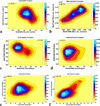Destabilization of the MutSα's protein-protein interface due to binding to the DNA adduct induced by anticancer agent carboplatin via molecular dynamics simulations
- PMID: 24061854
- PMCID: PMC3880575
- DOI: 10.1007/s00894-013-1998-2
Destabilization of the MutSα's protein-protein interface due to binding to the DNA adduct induced by anticancer agent carboplatin via molecular dynamics simulations
Abstract
DNA mismatch repair (MMR) proteins maintain genetic integrity in all organisms by recognizing and repairing DNA errors. Such alteration of hereditary information can lead to various diseases, including cancer. Besides their role in DNA repair, MMR proteins detect and initiate cellular responses to certain type of DNA damage. Its response to the damaged DNA has made the human MMR pathway a useful target for anticancer agents such as carboplatin. This study indicates that strong, specific interactions at the interface of MutSα in response to the mismatched DNA recognition are replaced by weak, non-specific interactions in response to the damaged DNA recognition. Data suggest a severe impairment of the dimerization of MutSα in response to the damaged DNA recognition. While the core of MutSα is preserved in response to the damaged DNA recognition, the loss of contact surface and the rearrangement of contacts at the protein interface suggest a different packing in response to the damaged DNA recognition. Coupled in response to the mismatched DNA recognition, interaction energies, hydrogen bonds, salt bridges, and solvent accessible surface areas at the interface of MutSα and within the subunits are uncoupled or asynchronously coupled in response to the damaged DNA recognition. These pieces of evidence suggest that the loss of a synchronous mode of response in the MutSα's surveillance for DNA errors would possibly be one of the mechanism(s) of signaling the MMR-dependent programed cell death much wanted in anticancer therapies. The analysis was drawn from dynamics simulations.
Figures










References
-
- Kunkel TA. DNA Replication Fidelity. J Biol Chem. 1992;267:18251–18254. - PubMed
-
- Iyer RR, Pluciennik A, Burdett V, Modrich PL. DNA Mismatch Repair: Functions and Mechanisms. Chem Rev. 2006;106:302–323. - PubMed
-
- Peltomaki P. Role of DNA Mismatch Repair Deffects in the Pathogenesis of Human Cancer. J Clin Oncol. 2003;21:1174–1179. - PubMed
-
- Wang D, Lippard SJ. Cellular Processing of Platinum Anticancer Drugs. Nature. 2005;4:307–321. - PubMed
Publication types
MeSH terms
Substances
Grants and funding
LinkOut - more resources
Full Text Sources
Other Literature Sources

